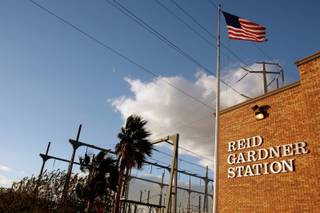
The coal-fired Reid Gardner Generating Station near Moapa is shown April 5, 2007. The spots near the smokestacks are “ghost” reflections of the lights on the plant, which can occur in digital cameras while shooting a point light source.
Tuesday, April 2, 2013 | 9:58 p.m.
NV Energy will roll out a major policy initiative Wednesday, announcing that it will shutter its coal-fired plants, increase investment in renewable energy and create thousands of construction jobs over the next 12 years.
Under the plan, Nevada’s coal plants would begin closing by the end of next year, and the company would accelerate investment in wind, solar, geothermal and natural gas to replace the coal energy going offline. The company estimates the plan could result in a nearly 4 percent increase in rates over the next 20 years, and the proposed legislation would limit the Public Utilities Commission's ability to approve the increases.
The utility plans to unveil the proposal it’s calling “NVision” on Wednesday at the Legislature as an amendment to Senate Bill 123.
“This does three things: it retires coal from Nevada, builds renewables, and it creates jobs,” said Tony Sanchez, NV Energy senior vice president.
The amendment calls for the accelerated closing of three of the four units at Reid Gardner, the controversial 553 megawatt coal plant in Moapa, by 2014. It leaves the fourth unit operating until 2017, after which the utility would have no coal plants operating in Southern Nevada.
U.S. Sen. Harry Reid, D-Nev., has relentlessly called for the closing of the plant, most recently during an address to the Nevada Legislature last month.
(Under the plan, the utility would not divest from its share of ownership in the Navajo and Valmy coal plants until 2017 and 2025, respectively.)
A state legislator familiar with the proposed amendment said NV Energy’s plan could position Nevada as a leader in renewable energy development in the wake of its divestment from coal.
“I applaud the utility in having the foresight and the courage to try to answer the questions about the future of coal in Nevada and their willingness to recognize that coal needs to be exiting stage left,” said Assemblyman David Bobzien, D-Reno, who chairs the Assembly Commerce and Labor Committee that could hear the bill if it passes the Senate.
Bobzien tempered his praise of the proposal with a cautionary note that legislators still need time to investigate the plan to see how the Legislature can achieve the goals of getting Nevada out of the coal business and firmly into the renewable energy business without adversely affecting industry and consumer interests.
“In the coming weeks the Legislature is going to have some questions about how we get there so that it’s done in a way that’s going to be predictable and stable for ratepayers,” he said.
In place of coal, NV Energy wants to invest in a 60-40 split of natural gas and renewables.
NV Energy would construct, acquire or contract for 600 megawatts of renewable energy in Nevada during the next five years.
The bill mandates that the utility own or operate 25 percent of that renewable energy.
This would be the first time the utility would own and operate renewable energy power plants, Sanchez said.
The company would also construct or acquire and own 1,000 megawatts of natural gas during the next five years and 1,000 more megawatts in the next 10 years with both construction or acquisition intended to be in-state.
The amendment also calls for the construction of natural gas pipelines and transmission lines to hook the new power plants into the grid.
The construction projects would bring about 4,700 construction jobs to Nevada and would result in about 200 permanent operations and maintenance jobs at the facilities.
NV Energy said it does not anticipate any layoffs from Reid Gardner because employees will be involved in ramping down the plant and could transition to new jobs at new facilities, said Rob Stillwell, spokesman for NV Energy.
All this comes at a cost to the ratepayer.
“NVision has an estimated compound annual growth rate in electricity prices of 1.65 percent, which includes the effects of inflation,” according to an NV Energy statement released to the Las Vegas Sun on Tuesday.
The utility’s amendment would call for the Public Utilities Commission of Nevada to review the plan upon legislative approval. The commission would have 210 days to review the plan, considering among other things that the cost is “just and reasonable in light of the elements of the plan,” according to a copy of the amendment obtained by the Las Vegas Sun.
The commission does not appear to have the ability to reject the plan; the amendment instructs the commission to “approve or modify” the utility’s proposal.
The utility would also charge ratepayers to recover all “just and reasonable” costs of renewable energy construction, maintenance, and operation.
NV Energy would also be able to recover costs for closing coal plants, including charging for unused coal inventory, contract termination, and decommissioning and remediation costs.
Such rate hikes would automatically begin on the first day of the next financial quarter after they were enacted.
The Public Utilities Commission could retroactively review rate hikes permissible under the plan during the next general rate case, a reversal of the current practice in which it reviews such rate increases before they take effect.
The wide-ranging amendment also covers several significant changes to the state’s Renewable Portfolio Standard, its renewable demonstrations programs and its net metering program.
The bill also mandates that the Nevada Department of Environmental Protection oversee the closure and remediation of its coal plants, a job that would have gone to the Southern Nevada Health District under current law.


Join the Discussion:
Check this out for a full explanation of our conversion to the LiveFyre commenting system and instructions on how to sign up for an account.
Full comments policy